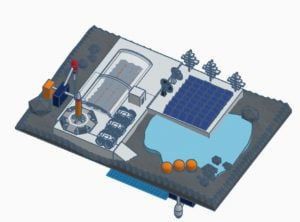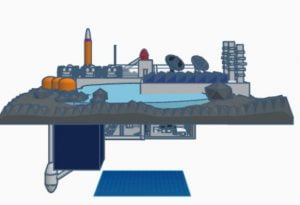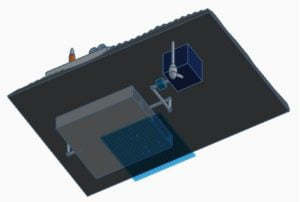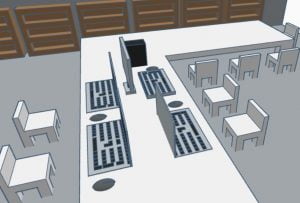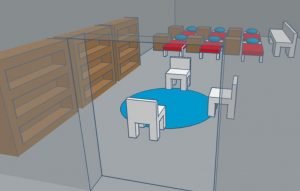Moon Camp Explorers Gallery 2020-2021
In Moon Camp Explorers each team’s mission is to 3D design a complete Moon Camp using Tinkercad. They also have to explain how they will use local resources, protect astronauts from the dangerous of space and describe the living and working facilities.
Team: Dreamers
Istituto Comprensivo “Margherita Hack” Maniago (PN) Italy 12
External link for 3d
|
Project description
The camp is primarily equipped with a launch pad. To the side of the launch pad is the parking area of the lunar rovers. A large greenhouse is built on the side of the launch area. At the same level are the solar panels. On the same platform there are also two antennas respectively for the radio connection with the ISS and the rover, and a larger one, which synchronized on the satellites, will allow access to the internet, which is essential for communications. At the base camp you enter through a system of two sliding doors, that prevent the excessive escape of oxygen and that lead to an elevator. The lift goes down to a first room where the astronauts can change their clothes. Then to the principal floor where there are the research laboratory, the dormitory, the canteen and the bathroom. In the laboratory the various activities will be carried out, for example geo composition, search of other sources of water, search of forms of life, experiments on the adaptation of both animal and plant body in conditions of microgravity… The laboratory is in communication with the reading room shared with the dormitory, where there will be books on astrophysics, astronomy, as well as literature for entertainment. The bathroom a compostable sanitary ware transports the “slags” to a particular department of the waste recycling plant, where they will be shredded and then taken via a system of pipes to the greenhouse where they will be used as fertilizer. |
|||
|
Where do you want to build your Moon Camp?
Close to the Lunar Poles Why did you choose this location?
The Moon Camp will be built near Lunar Poles because those are rich of water. Specifically in a crater in the lunar pole in the far side of the moon named Clavius where there is solid water. Moreover in this region there are extremely friable basalt rocks, which would make construction easier and faster. Moreover the moon camp positioned at a correct angle would not be subject to the danger caused by meteorites and asteroids. We projected it in proximity of a glacier, then passed its arctic circle. How do you plan to build your Moon Camp? Which materials would you use?
Using a rocket with interchangeable modules such as those recently used by SpaceX, which could transport various components faster and reduce costs. For the assembly itself on the moon, towing systems equipped with sensors could be used, in order to optimize the effort by the astronauts as much as possible. Use light materials to further facilitate the construction and maintenance of the station and materials that, due to their mechanical properties, allow it to withstand thermal shocks such as resins and carbon fiber as for airliners Explain how your Moon Camp will provide the astronauts with:
|
|||
|
Water
|
Food
|
Electricity
|
Air
|
|
The water will be taken from the nearby glacier with a heating system that brings the ice to extreme temperatures for about ten seconds, then the water, sterilized, will be transported via a pumping system to a storage chamber with a capacity of about 200 liters. When the water level inside falls below the guard level, the system resumes its activity until the chamber is filled again. Some studies pointed out that water present in the area amounts to 600 million tons, which would be enough to quench the thirst of 6 people for at least one million of years. |
In the greenhouses, terrestrial soil and some decomposers of our planet will be initially brought, subsequently the life cycle will automate the production process. At the beginning will be necessary do everything possible to preserve the fertility of the soil. First, numerous varieties of legumes will be planted with a dual function: legumes return part of the nutrients to the soil and replace meat in the astronauts’ diet; and the three-year crop rotation. Will also be planted: cereals, fruit on the plant such as strawberries, vegetables such as aubergines, courgettes, onions, potatoes, etc. |
The energy will be produced in 3 ways: |
The air will be produced by the trees and plants that will be planted in the greenhouse. |
|
Describe a day on the Moon for one of your Moon Camp astronauts
The astronauts wake up at 6 am. While some begin to prepare breakfast, the others go to the greenhouse |
|||


